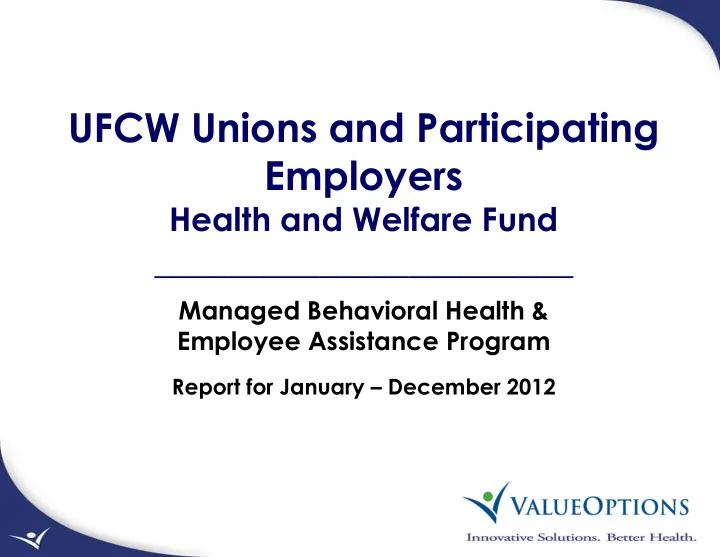

UFCW Unions and Participating Employers Health and Welfare Fund _______________________ Managed Behavioral Health & Employee Assistance Program Report for January – December 2012
AGENDA I. Introduction II. 2012 Behavioral Health Care Utilization III. 2012 Employee Assistance Program Utilization IV. Questions & Discussion
Introduction • 2012 marked the twenty-fourth year of ValueOptions service to the Fund membership (dating to 1988) • ValueOptions provides a dedicated team of clinical care managers and EAP counseling staff in our call center who are available to Fund members around the clock everyday. • In addition ValueOptions maintains a credentialed network of behavioral health providers and EAP counselors nationwide.
Managed Behavioral Healthcare Utilization Data 2012 • Membership Trends • Paid Claims Experience • Penetration Rates • Behavioral Health Utilization – Inpatient and other Acute Care • Outpatient Utilization
Membership Trends Average Membership per Month 10,604 10,217 9,996 12,000 9,205 10,000 8,000 6,000 4,000 2,000 0 2009 2010 2011 2012 The average membership served by the program shows a decreasing trend over the past four Plan years, down by 13% since 2009. The data in this report is based on a 2012 average membership count of 9,205 5
Paid Claims Experience Total of Paid Claims $529,021 $516,634 2009 2010 2011 2012 $600,000 Acute Care Subtotal $272,246 $275,457 $378,410 $417,287 $405,421 $500,000 $391,592 Outpatient Subtotal $119,346 $129,964 $138,124 $111,734 $400,000 Total of Paid Claims $391,592 $405,421 $516,534 $529,021 Per Employee per Month $5.29 $5.53 $7.29 $8.03 $300,000 Per Member per Month $3.08 $3.31 $4.31 $4.79 $200,000 Total Network Savings $264,509 $261,293 $327,594 $411,515 $100,000 Network Savings PEPM $3.58 $3.40 $4.62 $6.24 $0 2009 2010 2011 2012 The total of paid claims in 2012 is 2.4% higher than that in 2011. Less than 2012 US Medical Claims Cost Inflation. The acute care total went up 10% due to a 22% increase in the service units paid, which was partially offset by a decrease in the average paid per unit. The outpatient claims amount diminished by 19% as the number of visits paid declined by 15%. The rate paid per-employee and per-member-per-month increased by 10% and 11% respectively. The total of savings due to discounts on network claims has increased by 56% since 2009 (up by 74% when measured per employee per month). 6
Penetration Rates Program Penetration 393 359 342 338 400 350 300 250 200 150 100 50 0 2009 2010 2011 2012 In 2012 there were 338 members who had at least one paid claim for behavioral health service in 2012, representing 3.7% of all members. Over the last 4 years the access has ranged from 3.2% to 3.9%. Sixty members or 17% of those in care required acute care (inpatient and/or alternative levels of care). 2009 2010 2011 2012 Unique Mbrs - Inpatient 55 56 72 60 Inpatient Penetration Rate 0.52% 0.55% 0.72% 0.65% Unique Mbrs - Outpatient 327 344 365 324 Outpatient Penetration Rate 3.08% 3.40% 3.65% 3.52% Total Unique Mbrs in Care 342 359 393 338 Total Penetration 3.23% 3.51% 3.93% 3.67% 7
Behavioral Health Utilization – Inpatient and other Acute Care Acute Care Benefit Days Authorized 543 600 459 413 396 500 400 300 200 100 0 2009 2010 2011 2012 The total of acute care benefit days authorized in 2012 (inpatient, partial hospital, residential and intensive outpatient) is 15% less than the prior year because of decreases in admissions and in the average length of stay in care. These trends resulted in a rate of benefit days used per thousand members that is 8% lower for 2012 compared to 2011. 2009 2010 2011 2012 Acute Care Admisssions 72 70 95 83 Total Benefit Days Utilized 396 413 543 459 Admits / 1000 Members 6.8 6.8 9.5 9.0 Average Length of Stay in Care 5.5 5.9 5.7 5.5 Benefit Days / 1000 Members 37.3 40.5 54.3 49.8 8
Outpatient Utilization – Claims Based Paid Outpatient Visits 2,803 2,305 2,375 3,000 2,254 2,500 2,000 1,500 1,000 500 0 2009 2010 2011 2012 Eleven percent fewer members had a paid claim for outpatient services in the past year, and each member in care used 5% fewer visits. Over the entire membership, the number of outpatient visits paid per thousand members went down 8% from the prior year to 258, yet remained higher than the outcomes for 2009 and 2010. 2009 2010 2011 2012 Paid Outpatient Visits 2,254 2,305 2,803 2,375 Unique Mbrs seen in Outpatient 327 344 365 324 Average # of Visits / Mbr in Care 6.9 6.7 7.7 7.3 OP Visits / 1000 Members 212.6 225.6 280.4 258.0 9
Employee Assistance Program Utilization EAP Utilization Rates 1.67% 2.00% 1.22% 1.50% 1.14% 0.80% 1.00% 0.50% 0.00% 2009 2010 2011 2012 2009 2010 2011 2012 Average # of Subscribers 3165 2887 2719 2525 Total EAP Cases Opened 53 23 31 31 EAP Utilization Rate 1.67% 0.80% 1.14% 1.23% Although the number of members who used EAP counseling remained the same, the rate of access went up marginally to 1.2%, because of a decrease in the average number of employee members who were covered for EAP in 2012. EAP utilization has trend upward over the past three years. 10
Employee Assistance Program Case Distribution by Problems Reported Primary Presenting Problems Problem Types 2009 2010 2011 2012 Depression / Anxiety 22.6% 30.4% 19.4% 35.5% Marital / Relationship / Family 18.9% 21.7% 35.5% 29.0% Situational Adjustment 17.0% 8.7% 22.5% 16.1% Hyperactivity / Impulse Control 17.0% 0.0% 3.2% 9.7% Alcohol / Drug 11.3% 17.4% 6.5% 0.0% Depression / Anxiety moved from the third most common problem type presented in 2012 to the most common one. There were no members who presented to the EAP with an alcohol or drug problem in 2012, unlike the prior three years when the rate of these issues ranged from 6.5% to 17.4% of all cases. Hyperactivity / Impulse Control problems tripled in incidence from 2011 to 2012. 11
Questions & Discussion Thank you! We look forward to our continued partnership
Recommend
More recommend